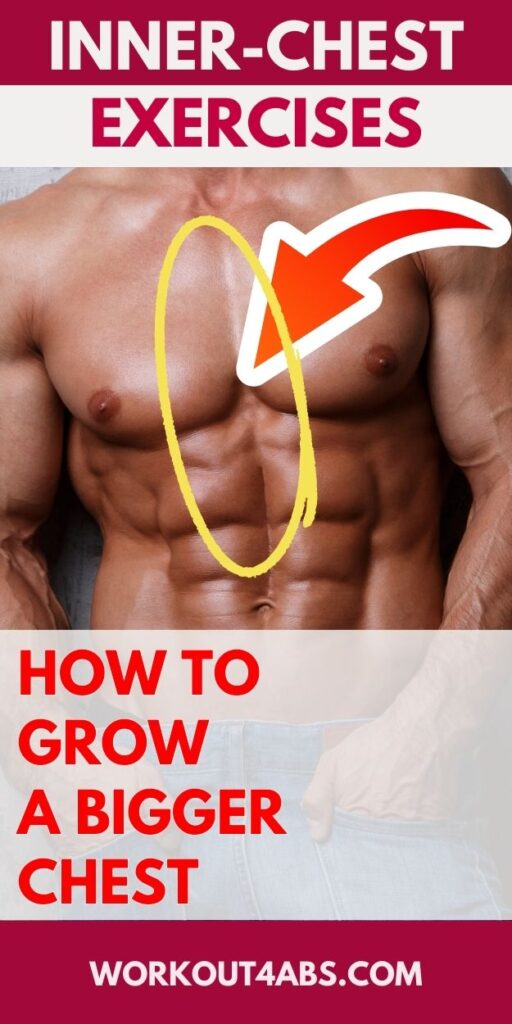You’re about to discover the best inner chest exercises. In the pursuit of a well-defined and sculpted chest, the inner chest line often remains a challenging target. In this article, we delve into eight highly effective inner chest exercises that will help you chisel, shape, and define this often elusive area, bringing symmetry and strength to your chest muscles.
Chest workout – 8 Inner Chest Exercises that Chisel the Inner Chest Line
If you enjoyed these tips, please save this pin to your Pinterest Board.

Svend Press
The Svend Press is a unique exercise that targets the chest, shoulders, and triceps while also engaging the core muscles. It involves pressing two weight plates together in front of your chest. Here’s a step-by-step guide on how to perform the Svend Press:
Equipment Needed:
- Two weight plates (typically 5-10 pounds each)
- An open space or gym area
Step-by-Step Instructions:
- Set Up:
- Begin by selecting two weight plates of your desired weight. It’s best to start with lighter plates if you’re new to the exercise to get a feel for it.
- Stand with your feet shoulder-width apart and maintain good posture throughout the exercise. Keep your chest up, shoulders back, and core engaged.
- Hold the Weight Plates:
- Hold one weight plate in each hand with your palms facing inward (towards each other). Your thumbs should be on the flat side of the plates, and your fingers on the outer rim.
- Positioning:
- Extend your arms in front of you, keeping them slightly bent at the elbows. The weight plates should be at chest level, and you should hold them close together, almost touching.
- Engage Your Chest:
- Begin the exercise by squeezing your chest muscles to press the weight plates together. Imagine you’re trying to crush something between the plates with your chest muscles.
- Press Together:
- Slowly and controlled, press the weight plates together by bringing your hands towards the center of your chest. Keep your elbows slightly bent throughout the movement.
- Squeeze and Hold:
- Once the weight plates are fully pressed together, squeeze your chest muscles as hard as you can. Hold this position for a moment to maximize the contraction.
- Return to Starting Position:
- Gradually release the pressure and open your arms back to the starting position, with the weight plates in front of your chest.
- Repeat:
- Perform the desired number of repetitions, typically in sets of 8-15, depending on your fitness level and goals.
Tips and Considerations:
- Start with lighter weight plates to master the technique and then gradually increase the weight as you become more comfortable with the exercise.
- Focus on proper form and controlled movements rather than using heavy weights. This exercise is about squeezing and engaging your chest muscles effectively.
- Keep your core engaged and maintain good posture throughout the exercise to avoid straining your lower back.
- Breathe steadily throughout the movement, exhaling as you press the weight plates together and inhaling as you return to the starting position.
The Svend Press can be a valuable addition to your chest and shoulder workout routine, helping to target your chest muscles in a unique way. It’s important to perform the exercise with proper form and gradually progress in weight to avoid injury and maximize its benefits. If you’re new to this exercise, consider seeking guidance from a fitness professional to ensure you’re performing it correctly.
If you enjoyed these tips, please save this pin to your Pinterest Board.

Dumbbell Squeeze Press
The Dumbbell Squeeze Press is a chest exercise that combines a traditional dumbbell press with an isometric hold to intensify the contraction of the chest muscles. This exercise is excellent for building chest strength and muscle size. Here’s how to perform the Dumbbell Squeeze Press:
Equipment Needed:
- Dumbbells of your desired weight
- An exercise bench
Step-by-Step Instructions:
- Set Up:
- Place an exercise bench flat on the ground and position it within a weightlifting area.
- Select a pair of dumbbells that are appropriate for your fitness level. Start with a weight that allows you to perform the exercise with proper form.
- Lie Down on the Bench:
- Sit down on the edge of the bench and carefully lie back, ensuring your head, shoulders, and buttocks are firmly positioned on the bench. Your feet should be flat on the ground.
- Hold a dumbbell in each hand with your palms facing forward (away from your body). Extend your arms fully, positioning the dumbbells directly above your chest.
- Position the Dumbbells:
- Instead of holding the dumbbells directly above your chest, bring them closer together so that they are nearly touching. Your palms should still be facing forward, and your elbows should be slightly bent.
- Engage Your Chest Muscles:
- Begin the exercise by squeezing your chest muscles to press the dumbbells together. Imagine that you are trying to crush something between the dumbbells with your chest muscles.
- Press the Dumbbells:
- While maintaining the squeeze and chest engagement, slowly press the dumbbells upward until your arms are fully extended but not locked at the elbows. This is similar to a traditional dumbbell press but with a continuous squeezing motion of your chest.
- Hold the Squeeze:
- At the top of the movement, when your arms are fully extended, continue to squeeze your chest muscles as hard as you can for a moment. This is the isometric hold that intensifies the exercise.
- Lower the Dumbbells:
- Gradually lower the dumbbells back to the starting position while maintaining the chest squeeze.
- Repeat:
- Perform the desired number of repetitions, typically in sets of 8-12, depending on your fitness level and goals.
Tips and Considerations:
- Focus on controlling the weights throughout the movement, especially during the squeeze and isometric hold.
- Breathe steadily throughout the exercise, exhaling as you press the dumbbells upward and inhaling as you lower them.
- Use proper form and avoid using excessive weight to prevent injury. The squeeze and isometric hold make the exercise challenging even with moderate weights.
- Ensure your entire back, including your head, shoulders, and buttocks, remain firmly on the bench throughout the exercise.
- If you’re new to this exercise, it’s a good idea to start with lighter weights to get the hang of it and then gradually increase the weight as you become more comfortable.
The Dumbbell Squeeze Press is an effective chest exercise that can help you develop strength and size in your chest muscles while also improving chest muscle engagement. Always prioritize safety and form when performing this or any other exercise.
Deficit Push Up
The Deficit Push-Up is a challenging variation of the standard push-up that targets the chest, shoulders, triceps, and core muscles. It involves elevating your hands on an elevated surface (creating a “deficit”) to increase the range of motion and the intensity of the exercise. Here’s how to perform the Deficit Push-Up:
Equipment Needed:
- A sturdy elevated surface (e.g., push-up handles, yoga blocks, stable boxes, or parallel bars)
Step-by-Step Instructions:
- Set Up:
- Place the elevated surface on the floor, making sure it’s stable and won’t move during the exercise.
- Assume a plank position with your hands on the elevated surface, slightly wider than shoulder-width apart. Your body should form a straight line from head to heels.
- Hand Placement:
- Position your hands on the elevated surface with your fingers pointing forward or slightly turned outward. Ensure your wrists are in line with your shoulders.
- Core Engagement:
- Engage your core muscles by bracing your abs and keeping your back straight. Avoid arching your lower back or sagging your hips.
- Descend:
- Lower your chest toward the elevated surface by bending your elbows. Keep your body in a straight line, and maintain a controlled pace throughout the descent.
- Full Range of Motion:
- Continue descending until your chest comes close to or touches the elevated surface. This is the point where the increased range of motion makes the exercise more challenging than a standard push-up.
- Push-Up:
- Push through your palms and extend your elbows to push your body back up to the starting position. Fully extend your arms, but do not lock your elbows at the top.
- Repeat:
- Perform the desired number of repetitions, typically in sets of 8-15, depending on your fitness level and goals.
Tips and Considerations:
- Maintain a straight line from head to heels throughout the exercise. Avoid letting your hips sag or sticking your buttocks up in the air.
- Focus on proper form and control, especially during the descent phase. Avoid “cheating” by using momentum to lift your body back up.
- You can adjust the height of the elevated surface to increase or decrease the difficulty of the exercise. A higher surface will make it more challenging.
- If you find the Deficit Push-Up too difficult at first, you can start by performing it with your knees on the ground until you build enough strength to progress to the full version.
- Breathe naturally throughout the exercise, inhaling as you lower your chest and exhaling as you push yourself back up.
The Deficit Push-Up is an effective exercise for building upper body strength and muscular endurance, especially in the chest and triceps. It’s important to maintain proper form to get the most out of the exercise and to avoid strain or injury.
If you enjoyed these tips, please save this pin to your Pinterest Board.

Home › Aesthetic Body Plan ›Inner Chest Exercises